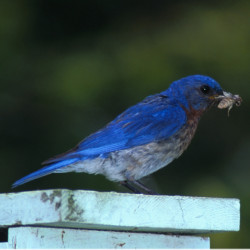Plants and Animals
BirdsCorals
Fish
Plants
Learn
BZS Schools' ProgrammeVisiting School Groups
Camps
Youth and Teen Programmes
Adult and Young Adult Programmes
Guides and Resources
Plants and Animals
Contact
General Inquiries
info@bzs.bm
Birds

Habitat:
At the time of colonisation, the Blue Bird was very common throughout the Bermuda Islands. Its main habitat was the Bermuda Cedar forests and it nested in holes in Cedar Trees. With the clearing of many forests, Bluebird territory shrank steadily and the population began a slow decline. The drop in Bluebird population became more severe later when competition for nest space from the House Sparrow (Passer domesticus), introduced in 1870, began. This competition increased after the 1950s when the Starling (Sturnus vulgaris), which had been introduced to North America, spread to Bermuda. Both these birds are native to Europe. Because of these events the territory occupied by the Bluebird in Bermuda has shrunk to small areas, particularly golf courses, where artificial nest boxes are more common and cared for.
Characteristics:
Bluebirds are beautiful little birds reaching 7 inches or 18 cm long, about the size of a House Sparrow but slimmer in build. The male Bluebird has a blue back and wing tops with a rusty-red breast and whitish belly (over). The cheeks are a slightly darker blue than the back. The female is a somewhat duller bird, with back and wing tops a reddish brown suffused with blue. Bluebirds feed principally on the ground but watch for prey from low perches on fence-posts or shrubs. They usually eat worms and insects. Nesting occurs from March to August and only in nest boxes.
Similar Species:
The Bluebird is almost unmistakable. There is no other small bird in Bermuda with a blue back. House sparrows are about the same size and can be seen in the same habitats but they are brown all over with no blue.
Conservation Importance:
Bluebirds are one of the few native breeding birds of Bermuda and are an important part of the original animal life of the islands. Their decline, caused almost entirely by man through habitat destruction and introduced bird competitors, is one of Bermuda’s tragedies. Without the intervention of the Bermuda Audubon Society, who in the 1950’s led the scheme to provide a large number of man made nest boxes (shown above), this bird would probably now be absent from Bermuda. Maintenance of the small remaining population can be helped by providing more nest boxes in gardens and tending them carefully. It is important to build boxes exactly according to plans available from the Audubon Society or their website.


